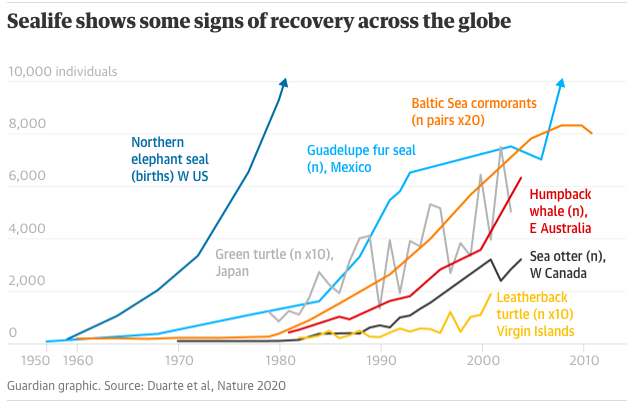
An Ocean Renaissance: There is Hope for Marine Life
Major review reports the recovery of marine life—but we are not done yet.
Recent reports suggest that marine life is slowly improving—with rebounding sea life, for example. However, the article reminds us: we need to keep working.
One article from The Guardian discusses reports of wildlife that have benefited from recent environmental efforts over the years. The good news spreads across the globe, from Humpback whales off Australia, elephant seals in the US and green turtles in Japan.
It’s not news that our oceans have taken a beating as a result of human life over the last few centuries. Overfishing, pollution and coastal destruction have all been exacerbated by humans. Conservation efforts, though isolated, have demonstrated remarkable resilience of the seas.
According to scientists, there is now knowledge and process enough to create an “ocean renaissance” for wildlife by 2050—and with it, bolster the services that the world’s people rely on like food, water, coastal protection and climate stability. As with all environmental issues, this affects humans, too.
However, this ocean renaissance will not come without action—and continued work. The measures needed to get there include protecting large swathes of ocean, sustainable fishing and pollution controls and waste control.
These efforts do cost money—that is no secret. However, scientists say the efforts would bring benefits to wildlife and future money spending that is already spent on environmental consequences, cleanup, etc.
This problem is far from over, though. The escalating climate crisis must be addressed to tackle problems like ocean acidification, loss of oxygen and the devastation to coral reefs.
The good news is that awareness of oceans and coastal habitats is growing, and habitats like mangroves and salt marshes rapidly soak up carbon dioxide and bolster shorelines against rising sea levels.
“We have a narrow window of opportunity to deliver a healthy ocean to our grandchildren, and we have the knowledge and tools to do so,” said Prof Carlos Duarte, of King Abdullah University of Science and Technology in Saudi Arabia, who led the review. “Failing to embrace this challenge, and in so doing condemning our grandchildren to a broken ocean unable to support good livelihoods is not an option.”
One of the most promising things about nature—and ocean wildlife especially—is that if you help it health, it does bounce back. While there’s still much to do, many scientists are optimistic, saying “we can turn the oceans around and we know it makes sense economically, for human wellbeing and, of course, for the environment.”
The new scientific review that suggests wildlife rebound found that global fishing is slowly becoming more sustainable and the deconstruction of habitats (like seagrass meadows and mangroves) is almost at a halt. The review, published in the journal Nature, seeks habitats even being restored in places like Tampa Bay, Florida and the Philippines.
In fact, populations of once-dangered animals are beginning to grow. Humpback whales that migrate from Antarctica to eastern Australia, whose populations were in the hundreds in the 1960s, have grown to over 40,000 today. Sea otters in western Canada have risen from just dozens in 1980 to thousands now. In the Baltic Sea, populations of grey seal and cormorant are soaring.
The following graphic, taken from the journal Nature and published in the Guardian, shows how sea life has recovered in areas across the globe.

According to Professor Callum Roberts, one of the review’s team members, this restoration is a result in a somewhat recent shift in philosophy about the environment and nature. Now, humans are beginning to see the environment as not just beautiful, but crucial to our own livelihoods and health.
“We’re beginning to appreciate the value of what we’re losing and not just in terms of intrinsic beauty of the wildlife but in terms of protecting our livelihoods and societies from bad things happening, whether that be poor water quality in rivers and oceans or sea level rise beating on the doorstep of coastal areas,” said Roberts.
Global warming, climate change, ecosystem destruction and species loss are not straightforward, of course. There are still a number of marine problems from plastic waste to pollution to overfishing to raising temperatures. Fertilizer and manure continue to flood down waterways and enter the ocean, creating dead zones. Many areas of the world have marine life that are just barely holding on, and migration patterns of species are changing due to changes in ocean temperature.
Yet even in the grim view of environmental protection, there is hope. Scientists say that restoring the oceans by 2050 is a grand challenge, but with a global redoubling of conservation efforts, it can be achieved.